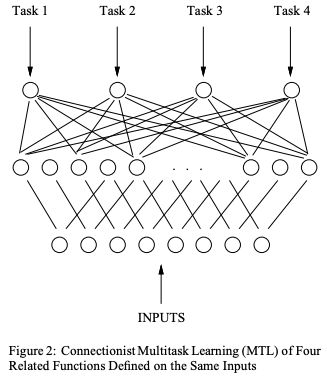多标签分类与多任务学习
多标签分类与视觉属性预测
0. 问题概述
对于标签分类问题,表示事物本身可以分为多个类别,但是对于每一个样本存在至少一个类别,例如分类猫、狗、植物、动物。一个样本是猫的同时,又属于动物。因此就不能再像以往的模型一样,输出用softmax激活函数激活,因为我们最终的输出标签可能同时有很多的类,例如鸟类有羽毛和啄。
1. 搭建模型
通常对多标签任务可以采取两种网络模型,一种是直接输出一个全连接层分支,最后一层输出的神经元数应与标签数量相同,使用Sigmoid函数激活,将数值映射在0~1之间。不像Softmax函数,最后一层输出层数值之和并不等于1,而是全部都介于0与1之间,这样我们便可以设置一个阈值,当某类输出层数值大于这个阈值,则判断该标签为Positive,反之为Negative。模型如下图所示:
假设我们的图像属性类别为 C ∈ { c 1 , c 2 , . . . , c N } C \in \{c_1,c_2,...,c_N\} C∈{c1,c2,...,cN}, N N N个标签类。最后一层的输出为 f ∈ R b a t c h × N f \in \mathbb{R}^{batch \times N} f∈Rbatch×N,经过Sigmoid函数激活输出的值在0-1之间,则判断属性时只要设置阈值 t h r e s h thresh thresh,大于阈值表示该标签存在,否则不存在:
c i = { 1 f i ≥ t h r e s h 0 f i < t h r e s h c_i = \left\{\begin{matrix} 1 & f_i \geq thresh \\ 0 & f_i < thresh \end{matrix}\right. ci={10fi≥threshfi<thresh
2. 损失函数与标签数据平衡
由于最后的激活函数是Sigmoid函数,因此我们需要用二分类的损失函数:Binary Cross Entropy。假设预测为 x x x,标签为 y y y, x x x为经过激活函数Sigmoid的结果。则我们可以构建损失函数:
l ( x n , y n ) = − ω n [ y n ⋅ log x n + ( 1 − y n ) ⋅ log ( 1 − x n ) ] l(x_n,y_n)=-\omega_n \begin{bmatrix} y_n\cdot \log x_n +(1-y_n) \cdot \log(1-x_n) \end{bmatrix} l(xn,yn)=−ωn[yn⋅logxn+(1−yn)⋅log(1−xn)]
我们会考虑到,不同的标签会存在正样本与负样本失衡的情况,例如300张图像中,红色翅膀属性有100,蓝色翅膀属性有200,正负样本不均匀,因此需要我们调节正负样本比例,但是数据不好扩增,因此我们可以修改损失函数:
l n , c = − ω n , c [ p c y n , c ⋅ log x n , c + ( 1 − y n , c ) ⋅ log ( 1 − x n , c ) ] l_{n,c}=-\omega_{n,c} \begin{bmatrix}p_c y_{n,c}\cdot \log x_{n,c} +(1-y_{n,c}) \cdot \log(1-x_{n,c})\end{bmatrix} ln,c=−ωn,c[pcyn,c⋅logxn,c+(1−yn,c)⋅log(1−xn,c)]
其中 ω \omega ω为调节不同属性的重要性,例如我希望模型更倾向于红色翅膀属性预测的正确性,可以在该类下调大比例。 p p p为调节正负样本均衡的参数,例如在红色翅膀属性下,有100个正例,400个负例,则在该属性下的 p p p我们可以设置为: 400 100 = 4 \frac{400}{100}=4 100400=4。在Pytorch框架中函数torch.nn.BCEWithLogitsLoss实现了该功能,其中 ω \omega ω对应超参 w e i g h t weight weight, p p p对应超参pos_weight。更多细节见BCEWithLogitsLoss。
3. 视觉属性预测
基于深度学习的视觉属性通常预测方法包括多标签分类与多任务学习,在TPAMI 2018一篇文章中提到:
Attribute learning problem can be formulated in the multi-task learning framework, where each task corresponds to learning one semantic attribute.
属性学习问题可以在多任务学习框架中形成,每个任务对应学习一个语义属性。

即可以在最后一层连接多个softmax二分类层或者用Sigmoid激活向量做多属性预测,通常其也会加入原物体类别信息,这样是防止偏见性。例如海豹在海水中,蓝色并不能作为海豹的属性,加入人为先验会更好一些,当然也可以直接进行属性预测。


在论文MAAD-Face: A Massively Annotated Attribute Dataset for Face Images中提供了人脸属性的标注,数据集来源于VGGFace2,在该数据集上训练了一个人脸属性模型,具体便是采用多任务学习的方法。Backbone便采用了Resnet50,最后的特征共享,并行输出多个全连接层。例如性别一栏,人只有男女之分,因此我不需要对男女进行二分类,而是直接分类性别,非男即女。种族也是,只有黄种人,白种人和黑种人,这个分支只输出3类。而人的胡子却不一样,有的人会同时有山羊胡和痄腮胡等,因此需要多个二分网络,最终将多个任务的交叉熵loss直接求和即可。这里值得提及一下pytorch的多输出网络方便的实现方法,以及多任务交叉熵Loss的写法,首先大概展示下网络的架构,与论文Multi-task deep neural network for multi-label learning中一个架构相似,如下图(a)所示:
下方代码主要部分是函数_make_multi_output,这里需要注意的是nn.ModuleList,因为循环中没有顺序,所以不能用nn.Sequential。如果不加nn.ModuleList而只用列表存储,则在model.cuda时不会将列表中的模型参数放入GPU,因为列表不会被识别为pytorch的方法。
class ResNet(nn.Module):
def __init__(self, block, layers, attribute_classes):
self.inplanes = 64
super(ResNet, self).__init__()
self.conv1 = nn.Conv2d(3, 64, kernel_size=7, stride=2, padding=3,
bias=False)
self.bn1 = nn.BatchNorm2d(64)
self.relu = nn.ReLU(inplace=True)
self.maxpool = nn.MaxPool2d(kernel_size=3, stride=2, padding=1)
self.layer1 = self._make_layer(block, 64, layers[0])
self.layer2 = self._make_layer(block, 128, layers[1], stride=2)
self.layer3 = self._make_layer(block, 256, layers[2], stride=2)
self.layer4 = self._make_layer(block, 512, layers[3], stride=2)
self.avgpool = nn.AvgPool2d(7, stride=1)
self.layers = self._make_multi_output(block, attribute_classes)
for m in self.modules():
if isinstance(m, nn.Conv2d):
nn.init.kaiming_normal_(m.weight, mode='fan_out', nonlinearity='relu')
elif isinstance(m, nn.BatchNorm2d):
nn.init.constant_(m.weight, 0.001)
nn.init.constant_(m.bias, 0)
def _make_layer(self, block, planes, blocks, stride=1):
downsample = None
if stride != 1 or self.inplanes != planes * block.expansion:
downsample = nn.Sequential(
nn.Conv2d(self.inplanes, planes * block.expansion,
kernel_size=1, stride=stride, bias=False),
nn.BatchNorm2d(planes * block.expansion),
)
layers = []
layers.append(block(self.inplanes, planes, stride, downsample))
self.inplanes = planes * block.expansion
for i in range(1, blocks):
layers.append(block(self.inplanes, planes))
return nn.Sequential(*layers)
def _make_multi_output(self,block,attribute_classes):
"""
Created by Ruoyu Chen on 07/15/2021
"""
layers = []
for i in range(attribute_classes):
layers.append(nn.Linear(512*block.expansion, 2))
return nn.ModuleList(layers)
def forward(self, x):
x = self.conv1(x)
x = self.bn1(x)
x = self.relu(x)
x = self.maxpool(x)
x = self.layer1(x)
x = self.layer2(x)
x = self.layer3(x)
x = self.layer4(x)
x = self.avgpool(x)
x = x.view(x.size(0), -1)
outs = []
for layer in self.layers:
outs.append(layer(x))
return outs
损失函数需要注意的是outs和labels的shape:
class MultiBranchLabelLoss(nn.Module):
def __init__(self):
super(MultiBranchLabelLoss, self).__init__()
self.criterion = nn.CrossEntropyLoss() # Input (N,C), Target (C)
def forward(self, outs, labels):
"""
outs: List[Torch_size(batch,2)]
labels: Torch_size(batch, attributes)
"""
loss = 0
for out,label in zip(outs,labels.t()):
# out: Torch_size(batch,2)
# label: Torch_size(batch)
criterion_loss = self.criterion(out, label)
loss += criterion_loss
return loss
4. 物体检测的属性数据集
最早的关于物体检测中的属性分布,原网站https://vision.cs.uiuc.edu/attributes/,基于Pasc VOC2008标注,2009年的一篇文章。
最新根据CVPR2021的一篇文章Learning To Predict Visual Attributes in the Wild的统计,有如下的最新的物体检测相关属性数据集:

5. 多任务学习
Multitask Learning: A Knowledge-Based Source of Inductive Bias


6. 根据多标签学习训练Pasc VOC2008属性
首先,根据pasc voc2008数据集,下载:https://www.kaggle.com/sulaimannadeem/pascal-voc-2008
代码及结果请见我的github:https://github.com/RuoyuChen10/Multi-label-on-VOC2008-attributes

